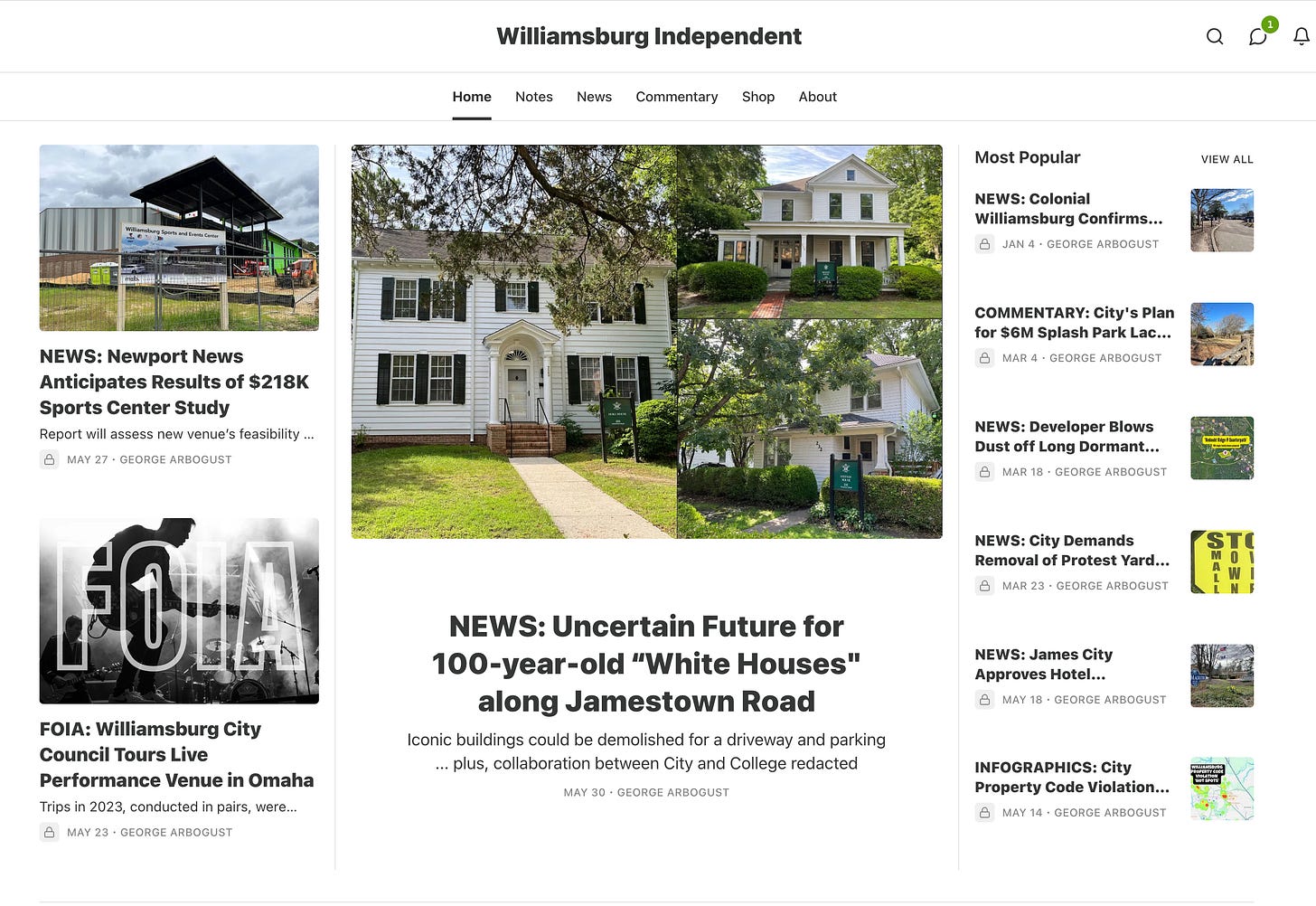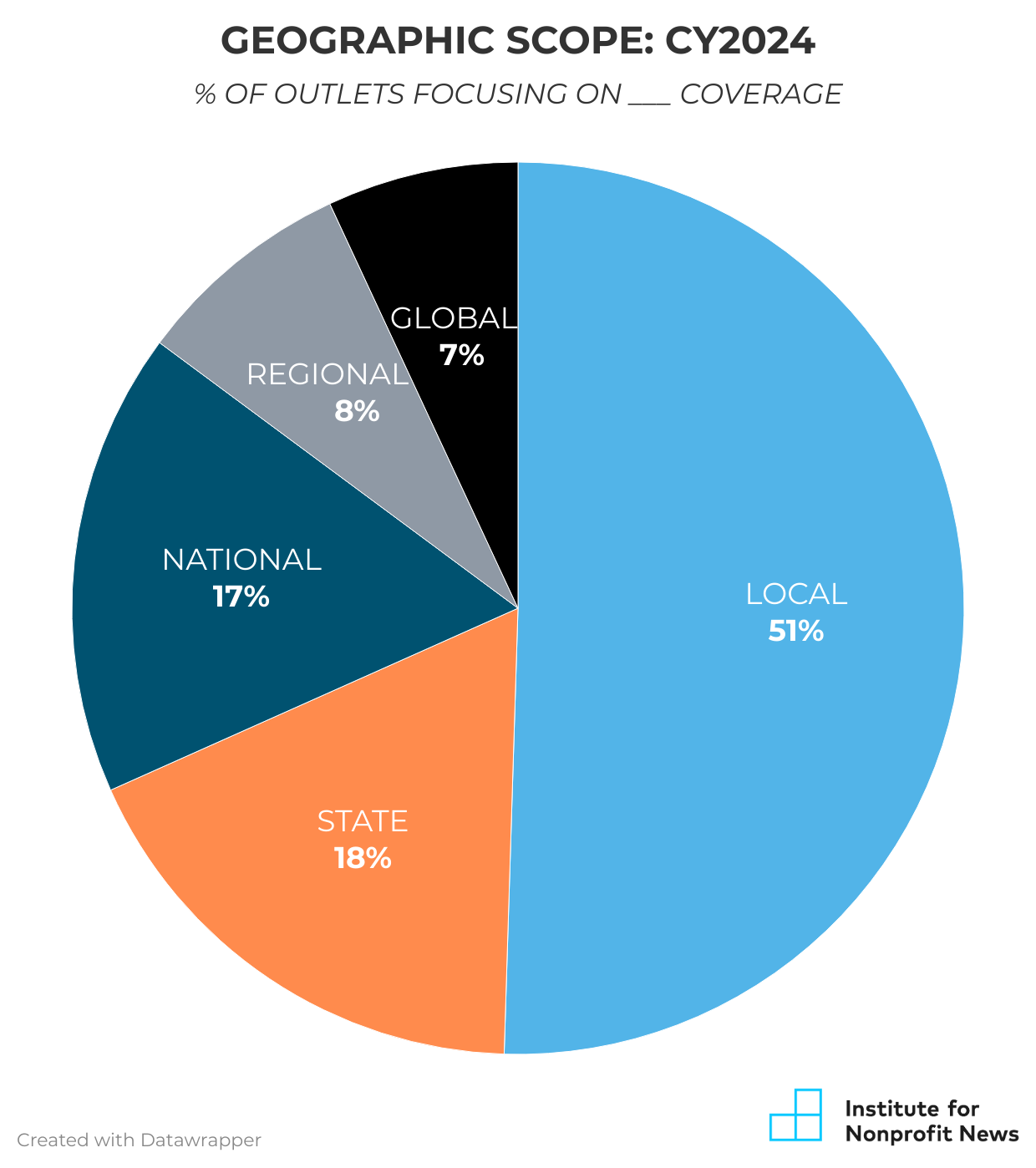A recent shot of the homepage of independent journalist George Arbogust’s site the Williamsburg Independent.
For Zach Tecklenburg, it started with a question—actually, a few questions. It was the pandemic. Like a lot of folks, Tecklenburg had bought a bike as a way to get outside. When he wasn’t working, he’d pedal around Des Moines’ extensive bike trail system and wonder what the heck was going on.
“As I was riding different trails around the metro, I kept wondering, what is up with that? When is that going to be done?” he says. “I saw a lot of stories that weren’t being covered that I thought people might be interested in.”
Tecklenburg had years of experience as a journalist. He’d started as a reporter and producer, worked his way up to assistant news director at a local TV news station. But he’d left that job for one with less stress and more predictable hours. That urge to get answers to his questions, though—well, that’s a little harder to leave behind.
“I was feeling a bit of a creative void,” he says. “I missed content creation, particularly newsier content creation.”
So, Tecklenburg decided to start a weekly newsletter focused on stories he thought weren’t being covered. DSM Bike Notes tackles everything from trail closures to new businesses catering to riders, providing central Iowa’s surprisingly large cycling community with in-depth pieces on projects otherwise ignored by local media. The response has been solid. Within six months, Tecklenburg had over 700 subscribers. He regularly gets thank-you notes from readers. He even landed ads from several area businesses.
“The response has been really, really good. I’m shocked how good,” he says. “We have a very big and active cycling community in Iowa, and no one was creating content to be consumed by cyclists. The other news outlets in the area—TV, newspapers—they’ll do stories on biking from time to time, but it’s for a broad audience. They leave out a lot of detail that I know cyclists are interested in.”
Tecklenburg isn’t the only one filling a local news niche. While alarms have been sounding over the expansion of news deserts, cuts at newspapers, closures of others, and the diminishing reach of local TV, there’s also been a rush into the space.
Some of it looks similar to what came before. Larger organizations like the nonprofit Colorado Sun and Texas Tribune have newsrooms full of reporters. They cover everything from breaking news to politics. And they’re leaning into local news coverage thanks to grants from the American Journalism Project. But they’re trying something different: setting up regional news hubs focused on covering communities rather than feeding stories to a central newsroom.
Other outlets like Lookout Local are trying to build robust newsrooms that depose area newspapers as the No. 1 source for local news. It seems to be working. Its first venture, Lookout Santa Cruz, grabbed a Pulitzer Prize last year. It’s second, Lookout Eugene-Springfield, covering Oregon’s second-largest metro, just launched with $175,000 in advertising already booked.
But it’s the smaller operations that seem to be really filling the local news niche. While there isn’t a specific tally of local news outlets on platforms like Substack, Ghost, and Beehiiv, anecdotally, there’s significant growth in the space. A recently released survey by the Institute for Nonprofit News showed that just over 50% of its 500-plus member sites focus on local news—the first time that’s happened in the organization’s eight-year history. LION Publishers—it’s an acronym for local Independent online news—has nearly 600 member sites across the U.S. and Canada and helps with sustainability plans, training, and occasionally even funding.
Over half of the member sites of The Institute of Nonprofit News now focus on local news.
Naomi Krueger runs one of them. She lives in Roseville, Minnesota, one of the Twin Cities’ many suburbs. While there’s plenty of regional coverage from powerhouses like the Minnesota Star Tribune and Minnesota Public Radio, Roseville itself doesn’t get a lot of attention. There’s no local newspaper. There’s no designated reporter covering city activity. And that bothered Krueger.
“Every election season, I wished that there was someone covering our local candidates—especially city council and school board candidates. I just kind of looked around, asking, ‘Is anyone doing any local reporting?’ No one was doing it. And finally, I was just like, ‘You know what? Maybe I'll do it!’”
Krueger launched the Roseville Reader in September 2024. She gave herself three months to see if she liked it. To see if anyone would read it. To see if she could make any money. She’d worked as a reporter right out of college, so she knew the ropes. She also knew that, for her sanity, she needed to keep the focus narrow. She was only going to write two or three articles a week. She wasn’t going to cover breaking news or area sports. She wanted to write the kind of stories she was craving—local government roundups, school district news, and area business stories—the kind of stuff she calls “slow news” that doesn’t need to be posted immediately.
Like Tecklenburg, Krueger has seen a solid response to her work. She’s amassed nearly 800 subscribers, with 17% paying for a subscription. More importantly, city officials have welcomed the coverage, granting her access whenever necessary. She’s had coffee with the mayor, sit-downs with the school superintendent and the city manager.
“They’ve all said that they need the coverage,” Krueger says. “The city has a newsletter, but that has its limitations. It’s marketing. It’s not the news.”
The Williamsburg Independent’s George Arbogust sits at the opposite end of the spectrum. His niche is government accountability, particularly focusing on land development and housing in the historic triangle between Williamsburg, Yorktown, and Jamestown, Virginia. There’s plenty of media around—from daily papers to regional news outlets. They cover the meetings and the major events—stuff Arbogust doesn’t really engage in unless it’s relevant to his work. Instead, he’s the guy reading the reports no one else bothers to look at.
“Once you start reading, it’s like going down a rabbit hole,” he says. “You’ll read something and think, ‘Oh, that’s interesting.’”
And he’s found plenty of interesting stuff. He’s broken news about questionable land deals, created detailed infographics from city and county data, and chronicled his battles with Williamsburg over attempts to limit FOIA access. He discovered that city officials flew to Omaha to visit a live music venue. He’s tracked the progress of plans for an oddly hush-hush children’s park in Williamsburg. And he recently uncovered joint plans between the city and the College of William and Mary to demolish a series of century-old houses for a driveway and parking lot. Throughout it all, Arbogust’s goal is to make sure people know what their local government is doing—or in Williamsburg’s case, keeping hidden—in their name.
“I think the desire for information and accountable government isn’t a left or right thing,” Arbogust says. “I find that people are interested when I approach an issue of not being able to get information. Left, right, middle, whatever—they're interested in that.”
So much so that Arbogust is going all in on The Williamsburg Independent. While the site is only six months old, he’s making it his full-time job. He has revenue coming in. His subscription base is growing quickly. And he feels like he’s making a difference.
“I've actually had a few people reach out to me here locally that were like, ‘Oh, I used to be a reporter, or I was in the industry, and, you know, I appreciate what you're doing,’” Arbogust says. “That makes me think that this might be something I can finish out my career with. The big question is whether I can make enough money out of it. Right now, I'm all subscriber-supported, and I'd like to continue with that model. I don't want to have to waste my time selling advertising. I've done that before. It sucks. So, I’d rather generate good content and hope it sells itself. And so far, it has.”
And that’s the key for local independent sites: they don’t take millions to run. They just need to generate enough revenue to keep one or two reporters asking questions, digging into documents, and telling stories that would otherwise go uncovered. And as all three have found, there’s an audience for their work. Just because larger media outlets have pulled back on coverage doesn’t mean there’s no hunger for it. Readers will be there for as long as these journalists want to do the work.
“I don’t know what my end goal is for it,” Tecklenburg says. “I don’t think it will go on forever and ever and ever, but I’m trying to enjoy it for now. It’s a fun, creative outlet—and way more fulfilling than I thought it would be.”
Got the Inside Track?
Do you have some essential info or were you just named the new creative director of Consumer Reports like Michael McCormick (Mags, GD, ’00)? If so, then let JMM know by sending that juicy news on over to jeff.inman@drake.edu. JMM will treat it like this press release naming next year’s Dotdash Meredith apprentices and tell everyone about it.
Finally, Kermit for president!
Editor’s Note: Like the network TV shows of old, JMM will be going on a summer hiatus. There might be occasional newsletters. There might not. Regardless, Season 4 of the Journalism Monday Memo will begin in late August. Until then, enjoy summer—and remember to wear sunscreen.







Thanks Professor!
I'm doing the same thing, hyperlocal news on Substack. I'm using my journalism skills to cover the community I live in, and it's highly rewarding -- not in dollars, of course, but in impact. https://sammamishlocalnews.substack.com/.